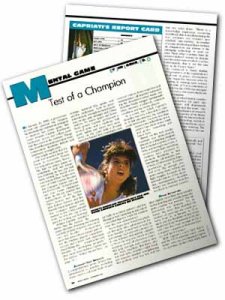A new regimen of strength and flexibility enhancing exercise produces measurable results.
 World Tennis Magazine
World Tennis Magazine
September 1989
MENTAL GAME
By Jim Loehr, Ed. D
Test of a Champion
On January 26, 1989, a precocious 12-year-old entered the Virginia Sportsmedicine Institute in Arlington to improve her tennis game. Her name: Jennifer Capriati. Forehands, backhands, serves and volleys were not discussed at the institute. Things like wrist flexion and extension, body composition, flexibility deficits and quadricep strength were.
One might assume that Capriati had traveled from her home in Grenelefe, Florida, for help with an injury. Not so. She had no aches, pains or complaints. And her tennis was thriving. In fact, she had been setting the world of junior tennis ablaze. in the summer of 1988 Capriati became the youngest winner ever of the USTA Girls’ 18 Hard Court and Clay Court Championships. In ’89 she reached the quarterfinals of the Italian Open Juniors, won the Belgian Indoor juniors and the French Open juniors and was the youngest player ever named to the USTA national team. So why the trip to Virginia for testing and training?
Stefano Capriati, Jennifer’s father, had the answer: “Because this type of testing and training can help Jennifer improve even more and stay healthy…. Competitive sport has always been a major part of my life [Stefano played competitive soccer] and I know how important these things are…. I want to be sure Jennifer is developing properly.” (For more from Stefano Capriati see the sidebar, “Father Knows Best,” on page 32.)
JANUARY TEST RESULTS
A comprehensive series of tests was administered to Jennifer, including those used to calculate body fat percentage, maximal V02 uptake and aerobic endurance. Tests to determine muscle strength and Cybex analysis. To assess upper and lower body power Capriati performed a vertical jump and a medicine ball push. Agility and speed were measured on the court with a 20-yard dash, the Spider Test (running to pick up balls in a preset pattern) and the Hexagon Test (jumping in and out of a six-sided figure). A test for reaction time also was administered.
According to Janet Sobel, the physical therapist who administered the tests, Jennifer scored well in body fat percentage (12.8 percent), sit-ups (42 in one minute) and aerobic capacity (a 54 on the step test, which involves stepping on and off a bench or chair). Her grip strength and reaction time also were excellent. But there also was bad news. Jennifer’s right shoulder muscles needed strengthening. Her push-up total was low and her external rotators, lower trapezium and supraspinatus (all muscles surrounding the shoulders) tested weak. Her shoulder blade winged substantially when stressed, a relatively common condition among tennis players. As a result, says Sobel, Capriati’s shoulder was very vulnerable to injury. If left uncorrected, the condition could deteriorate. The tests also diagnosed some inflexibility in Capriati’s hips (both inner thigh and groin), hamstrings and lower back.
Based on the test results, Capriati was immediately placed on a training program that included a variety of flexibility and strength exercises. A series of eight daily stretching routines were prepared to promote flexibility in her hamstrings, calf muscles, lower back, achilles tendons, hips, quadriceps, groin, forearm and wrist. The strength program, using elastic tubing and light weights, focused on the internal rotators of the shoulder, supraspinatus, shoulder blades and shoulder muscles involved in external rotation.
APRIL RETESTING
After slightly more than three months on the training and conditioning program, Capriati was retested. The improvement was dramatic. For instance, she more than doubled the number of push-ups she could perform, from 16 in January to 35 in April, and the flexibility in her wrists improved from 90 percent to 95 percent. (See the chart on page 32 for a complete comparison between January and April testing.)
Both Capriati’s coach, Rick Macci, and the USTA national coach, Lynne Rolley, who has coordinated Capriati’s activities on the USTA team, have witnessed progress in her game. Says Macci, “The training and conditioning exercises have enabled Jennifer to spend less time on court and more time becoming a better all-around athlete. In just three months I’ve seen her become faster, stronger, more explosive and more flexible.” Rolley feels the increase in shoulder and upper-body strength has improved Capriati’s serve. “Her first serve has become a weapon and she’s now able to hit a deep spin for her second serve,” says Rolley. “The off-court conditioning seemed to improve the consistency of her serve over long matches. And her overhead is stronger.”
THE ROLE OF SPORT SCIENCE
Player confidence can be devastated and years of hard work and effort tragically undermined when debilitating injury strikes. just ask Andrea Jaeger and Tracy Austin, both victims of painful, disabling injuries that shortened successful careers. The Capriati story is just one example of how sport science and sports medicine can help young players reach their potential.
“What’s needed is better education and training in the sport sciences for both coaches and parents,” says Rod Dulany, president of the United States Professional Tennis Association. Dennis Van der Meer, president of the United States Professional Tennis Registry, agrees. “The days that tennis teachers and coaches will rely solely on past experience or personal intuition for making important decisions on player development are over,” Van der Meer says. “Sport science will be a major factor in coaching for the future.”
The American Coaches Effectiveness Program, founded by Rainer Martens, Ph.D., in 1981 to upgrade coaches’ knowledge of sport science, has certified more than 20,000 coaches in introductory sport science in the last two years alone. “There is a knowledge explosion occurring worldwide that is revolutionizing the way athletes are trained and coached,” says Martens. “As coaches of young developing athletes,we have an obligation to stay abreast of the emerging technology in sport science. Manv other countries have developed delivery systems to disseminate this information to their coaches. Unfortunately, that is not the case here in the United States.”
So convinced is David Markin, USTA president, of the organization’s critical role in player development that he began his two-year term by expanding an existing sport science advisory team of 5 to a committee of 23. And it was the USTA that arranged Capriati’s visit to the sports medicine facility in Virginia.
‘The way in which tennis coaches prepare themselves for entry into their profession will dramatically change over the next five years,” says Paul Roetert, coordinator of research for the USTA. “Coaches of the future will be armed with the latest technology in exercise physiology, nutrition, biomechanics, sports medicine, sport psychology and motor learning. The science of coaching tennis is becoming a reality.”
FATHER KNOWS BEST
- Stefano Capriati devotes most of his time to organizing and assisting with Jennifer’s tennis. He believes no child can become great today without parental involvement.
- Believes that there is a fine line between supporting children and being too pushy.
- Believes his primary role is to protect Jennifer both physically and emotionally and “to provide her with what she needs.”
- Believes Jennifer shouldn’t read many of the stories written about her. “I don’t want her to feel the pressure to live up to what evervone is saying…. It’s tough enoug@ on adult players to read that stuff. It’s too much for a 13-year-old.”
- Believes footwork, balance and movement are the keys to greatness. He began teaching Jennifer about footwork and balance when she was 4 years old. Proper stroke mechanics, he says, are a function of good footwork.
- Believes sport science and sports medicine are the wave of the future. “We must do everything we can to protect and nourish young players. Sport science can help lead the way.”
CAPRIATI’S REPORT CARD
| PUSH UPS SIT UPS GRIP STRENGTH VERTICAL JUMP HEXAGON SUPRASPINATUS LOWER TRAPEZIUS LOWER ABDOMINALS HIP ABDUCTORS HAMSTRINGS PECTORALS |
JANUARY 16 42 72 LBS. 13.S IN. 15.32 SEC. 85% 70% 50% RT 32″ |
APRIL 35 61 86 LB5. 14.S IN. 10.61 SEC. 100% 85% 55% RT 50″ |
